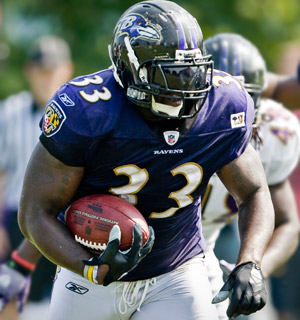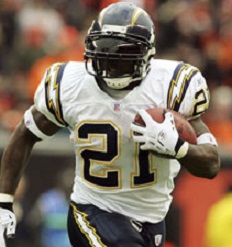The fortunes of the San Diego Chargers had changed
dramatically since the 4-12 finish of 2003 as they met the Kansas City Chiefs
on November 28, 2004. Head Coach Marty Schottenheimer’s team had won four
straight games and was at 7-3 and even with Denver atop the AFC West. QB Drew
Brees (pictured at right), considered a disappointment following his first three seasons, was
breaking out in a big way, as was second-year TE Antonio Gates, while RB
LaDainian Tomlinson continued to be a top rusher and receiver out of the
backfield. The coaching of first-year defensive coordinator Wade Phillips brought
about a significant improvement with the defense.
The Chiefs were on an opposite trajectory. Having been a
13-3 playoff team in 2003, Kansas City had lost its last three games and was
struggling with a 3-7 record. Under Head Coach Dick Vermeil, the offense was
still productive, led by QB Trent Green and TE Tony Gonzalez, although star RB
Priest Holmes was out with a knee injury. The defense was at the root of the
club’s problems and ranked among the league’s least effective units.
There were 77,447 fans in attendance at Arrowhead Stadium
on a 35-degree day. The Chargers had the first possession and put together a
promising drive as WR Eric Parker gained 20 yards on a first-play end-around
and Drew Brees completed three passes and had a 14-yard run. However, the drive
stalled at the Kansas City 11 and Nate Kaeding’s 29-yard field goal attempt was
unsuccessful.
The Chiefs punted following a short series and San Diego
struck quickly. Brees threw to Parker for a 55-yard gain to the KC two and, two
plays later, LaDainian Tomlinson scored a touchdown from a yard out. Kaeding
added the extra point and the visitors were in front by 7-0.
The ensuing kickoff went out of bounds, giving the Chiefs
starting field position at their 40, and they went 60 yards in six plays. Trent
Green had passes to Tony Gonzalez (pictured below) for 12 and 27 yards and RB Derrick Blaylock,
the stand-in for Priest Holmes, ran for a five-yard TD. Lawrence Tynes
converted to tie the score at 7-7.
The Chargers punted following their next possession and a
penalty on the return had the Chiefs starting from their own six yard line. As
the game moved into the second quarter, consecutive carries by RB Larry Johnson
picked up 18 yards and, with Green passing effectively and Johnson runs mixed
in, Kansas City advanced methodically down the field. Green completed five of
his passes, two of them to Gonzalez for 22 yards and the longest covering 16
yards to TE Jason Dunn. The 13-play, 94-yard drive culminated in Johnson’s
six-yard touchdown run up the middle. Tynes added the point after and the home
team had a 14-7 lead.
The Chargers responded with a long drive of their own
that covered 70 yards in 12 plays. They converted three first downs, all on
passes by Brees, including a 17-yard toss to Parker on third-and-seven that set
up Tomlinson’s three-yard carry for a TD. Kaeding’s kick tied the score at
14-14.
Green passed Kansas City down the field on the next
series and Tynes kicked a 28-yard field goal that put the Chiefs back in front
by three. With time running out in the first half, Brees threw to WR Kassim
Osgood for a 27-yard gain to the KC 43 and two short completions to Tomlinson picked
up another nine yards, but Kaeding missed on a 52-yard field goal attempt and
the home team took a 17-14 lead into halftime.
Kansas City WR Dante Hall started the third quarter off
with a 77-yard kickoff return, but he fumbled at the end without being hit and
the Chargers gained possession at their five yard line. They managed to reach
their 45 before having to punt and the Chiefs punted it back following a
three-and-out series. On San Diego’s first play from midfield, Parker took off
for a 38-yard run to the KC 12 and, while the Chargers couldn’t reach the end
zone, Kaeding tied the score with a 25-yard field goal.
The teams exchanged punts before the Chiefs began to move
effectively in the closing minutes of the period. Green completed three straight
passes, the first to WR Johnnie Morton for 18 yards, and a throw to Gonzalez in
a third-and-nine situation gained 23 yards to the San Diego 31. On the second
play of the fourth quarter, Blaylock broke away for a 22-yard touchdown. Tynes
missed the extra point, but Kansas City was back in front at 23-17.
Brees passed the Chargers back down the field, completing
six throws along the way. The longest was to WR Keenan McCardell for 23 yards
and the last to Antonio Gates for an 18-yard TD. Kaeding added the extra point
and San Diego was in the lead by a point at 24-23. It didn’t last long,
however, as Hall returned the ensuing kickoff 96 yards for a touchdown, this
time maintaining his grip on the football for the full distance. Green threw to
WR Eddie Kennison for a two-point conversion and KC was back on top by 31-24.
The Chargers ran into problems with penalties on their
next series, one of which wiped out a 51-yard pass play to Gates. However,
backed up to their 19 and facing second-and-22, Brees threw to Osgood for a
65-yard pickup to the KC 16 and, three plays later, he connected with Gates for
an 11-yard TD. Kaeding added the PAT and, with less than seven minutes
remaining in regulation, the score was again tied at 31-31.
San Diego got the ball back when a third-and-11 pass by
Green was intercepted by LB Donnie Edwards, who returned it 13 yards to the
Kansas City 32. The Chargers reached the 17 before Brees was sacked by CB
William Bartee and LB Scott Fujita for a loss of seven yards on third down, but
Kaeding kicked a 43-yard field goal and the visitors had a three-point lead.
The Chiefs regained possession with 2:15 left on the
clock, but after Green threw to Blaylock for six yards on first down, the next
three passes fell incomplete. San Diego held on for a 34-31 win.
“Everybody got their money’s worth today,” summed up San
Diego’s Coach Schottenheimer. “It was quite an exciting game.”
The Chargers, in ending a seven-game losing streak at
Kansas City, led in total yards (498 to 310), first downs (25 to 20), and time
of possession (36:46 to 23:14). The Chiefs turned the ball over twice, to none
suffered by San Diego, and while the Chargers were penalized more times (9 to
5), Kansas City’s infractions came at more inopportune times.
Drew Brees completed 28 of 37 passes for 378 yards and
two touchdowns while giving up no interceptions. With his two long carries,
Eric Parker led the Chargers with 58 rushing yards and also caught three passes
for another 78 yards. LaDainian Tomlinson (pictured at left) gained just 46 yards on 21 attempts
that included two TDs but also had 10 pass receptions for 57 yards. Antonio
Gates gained 92 yards on his 7 catches that included two for scores and, thanks
to the one long gain, Kassim Osgood matched the yardage total on his two receptions.
For the Chiefs, Trent Green was successful on 21 of 34
throws for 208 yards with no TDs and one interception. Tony Gonzalez caught 8
passes for 105 yards. Derrick Blaylock rushed for 75 yards on 8 carries that
included two touchdowns and Larry Johnson ran the ball 10 times for 43 yards
and a TD. Dante Hall averaged 38.8 yards on six kickoff returns, one of which
resulted in a touchdown and another that came close.
The Chargers went on to win their next three games, and
four of their last five, to finish first in the AFC West with a 12-4 record.
They lost their Wild Card playoff contest to the New York Jets in overtime.
Kansas City reeled off four wins following the loss to the Chargers but lost
the season finale in the rematch at San Diego to place third in the division at
7-9.
Drew Brees ranked second in the AFC with a 104.8 passer
rating, gaining 3159 yards with 27 TD passes against just seven interceptions.
He was selected to the Pro Bowl, as were both LaDainian Tomlinson, who ran for
1335 yards and a league-leading 17 rushing touchdowns, and Antonio Gates, who
caught 81 passes for 964 yards (11.9 avg.) and 13 TDs, and both of them also
were consensus first-team All-NFL selections.
Tony Gonzalez topped the NFL with 102 pass receptions,
which accounted for 1258 yards and 13 touchdowns. He was chosen to the Pro
Bowl. Trent Green topped the league in pass attempts (556) and the conference
in completions (369) and passing yards (4591). His 27 TD passes were a career
high.




















